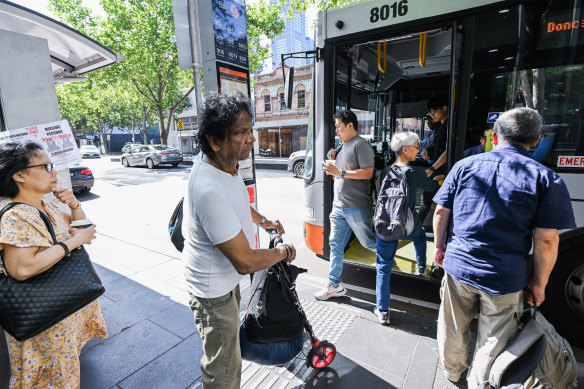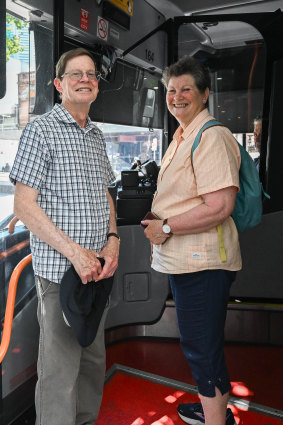Victorians have ditched their mykis for their car keys, with the COVID-19 years and flexible working leaving a permanent dent in public transport use.
Train, tram and bus passenger trips plunged to 40.9 million in October 2023, recently released government data shows, down 12.9 million trips – or 24 per cent – since the same month in 2019.

Melbourne’s weekend bus services have bucked the trend of lower passenger numbers since the pandemic. Credit: Joe Armao
Meanwhile, traffic on the state’s road network in November was just 3 per cent below 2019 levels, sparking warnings that Melbourne is losing the battle with congestion.
There was, however, one unlikely bright spot for the public transport usage – with Melbourne’s patchy Sunday bus services now attracting more passengers than ever.
Graham Currie, chair of public transport at Monash University, said his team’s research was showing Melburnians had replaced journeys they used to make on public transport with car trips.
“Traffic congestion is certainly a result,” he said. “Public transport remains Melbourne’s main solution to peak traffic congestion and we need to invest to ensure this continues.”
Melbourne’s Metro Trains experienced the biggest loss in passengers, down 32 per cent from pre-COVID levels in October, followed by Yarra Trams, which has lost 26 per cent.
V/Line train patronage was down 4 per cent in October from 2019 levels, with the state government boosting demand by slashing ticket prices to match the metro daily fare cap, which is now $10.60.
Trips on the city’s maligned bus network have fallen only 11 per cent – and it has been busier on weekends since the pandemic.
Melbourne University senior transport planning lecturer John Stone said city buses remained relatively popular because they were often the only public transport in outer suburbs.
Bus passengers were less likely to be commuters or employed in fields where remote work was possible, he said.
“Our train system has been built around a role of getting white-collar jobs into the city. [But] the people who used our bus system up until now are still dependent on that service,” Stone said.
Stone said the post-pandemic travel patterns showed the state government needed to improve bus services and push ahead with a plan to overhaul the network with faster, more frequent and more direct routes.
Infrastructure Victoria, the state government’s independent adviser, has been calling for a major reworking of the underutilised bus network to deliver better services, particularly for Melbourne’s fast-growing outer suburbs.
Data breaking down public transport patronage by day of the week is only available up to June.
Across trains, trams and buses, passenger numbers were down 30 per cent between Monday to Friday compared with June 2019. On Saturdays, numbers were down just 1.24 per cent – and up 4.5 per cent on Sundays.
Trams had a bumper June, with passenger numbers up 14 per cent on weekends – although that came after a decline of a similar level on weekends in May.

Helen Mangan (pictured with her brother Kevin Buckley) said she found buses easier than contending with weekend traffic.Credit: Joe Armao
Sunday bus passenger growth was up 8 per cent in May compared with the same month in 2019 – and up 15 per cent in June.
Stone said Victoria would need to boost frequencies across trains, trams and buses at off-peak times and weekends to make them a more attractive option and reverse the post-pandemic shift towards cars.
“We pride ourselves on being a 24-hour city but our public transport system is still based on the 9-to-5 and shops shutting at 12 o’clock on Saturday, so we do need to catch up,” he said.
Helen Mangan was on Lonsdale Street in the CBD on Saturday morning waiting for a 906 bus to take her to visit her sister-in-law in Warrandyte, which she said was a better option than driving.
“It’s easy on the bus – its seems a lot safer, and it takes off the pressure and the stress of driving,” she said.
While generally happy with the city’s bus services, Mangan said more frequent services would encourage her and others to use them more often.
The 906 departs every 15 minutes on weekdays but only every 20 or 30 minutes on weekends. Some busy bus routes – such as the 800 from Dandenong to Chadstone – don’t run on Sundays at all.
“The trains on the Frankston line are every 10 minutes. People might use the buses if they were more regular,” Mangan said.
Mae Chong was also waiting for the 906 bus to visit her mother in East Doncaster. The CBD retail worker caught the same bus almost daily for about a decade until 2019 and said it was a good service, but the timetable let her down when she worked weekends or late at night.
“When I used to have to go to work in the midnight hours, they [buses] cut right out and getting home that late at night isn’t exactly safe,” she said.
Monash University’s Currie said public transport use could always be increased with lower fares and with increased frequency of service.
“However, this all costs government funding, which is in stress at present,” he said.
On January 1, daily full-fare tickets rose by 60¢ to $10.60, with concession fares rising by 30¢ to $5.30. It was the second fare increase in six months, following a surprise hike in June that bumped a full-fare daily pass up by 80¢ to $10.
A spokesperson for the Department of Transport and Planning said government officials “constantly review our public transport and road systems to ensure we’re responding to changes in travel”.
VicRoads was spending $340 million on a review of Melbourne traffic lights which was using more than 1000 traffic monitoring cameras and travel time sensors, which was “ensuring Victorians get to where they need to go, quickly and safely and reducing travel times”, the spokesperson said.
Get the day’s breaking news, entertainment ideas and a long read to enjoy. Sign up to receive our Evening Edition newsletter.
https://news.google.com/rss/articles/CBMijAFodHRwczovL3d3dy50aGVhZ2UuY29tLmF1L25hdGlvbmFsL3ZpY3RvcmlhL2hvdy1jb3ZpZC1jcnVuY2hlZC1tZWxib3VybmUtcy1wdWJsaWMtdHJhbnNwb3J0LXVzZS1hbmQtdGhlLXVubGlrZWx5LXdpbm5lci0yMDI0MDEwNS1wNWV2ZzYuaHRtbNIBAA?oc=5
2024-01-06 08:54:43Z
CBMijAFodHRwczovL3d3dy50aGVhZ2UuY29tLmF1L25hdGlvbmFsL3ZpY3RvcmlhL2hvdy1jb3ZpZC1jcnVuY2hlZC1tZWxib3VybmUtcy1wdWJsaWMtdHJhbnNwb3J0LXVzZS1hbmQtdGhlLXVubGlrZWx5LXdpbm5lci0yMDI0MDEwNS1wNWV2ZzYuaHRtbNIBAA
Bagikan Berita Ini














0 Response to "How COVID crunched Melbourne’s public transport use – and the unlikely winner - The Age"
Post a Comment